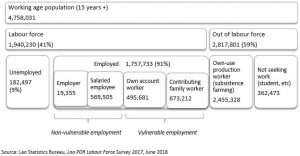Human trafficking in Lao PDR – who is vulnerable?
After more than 15 years of strong economic growth, the official poverty rate in the Lao PDR has declined significantly. Nevertheless, there remain many districts throughout the country with very high rates of poverty. In addition, many Lao people live just above the poverty line. These people are vulnerable to falling back below it in the event of agricultural or health shocks. This can make them vulnerable to human trafficking.
Lao PDR labour market
The Lao labour market is characterized by a high degree of economic vulnerability. Fewer than 600,000 persons are engaged in what the International Labour Organization describes as “non-vulnerable employment” (employers and salaried employees). A further 1.2 million persons are engaged in “vulnerable employment” (working for themselves or working without pay in the family business). Nearly 2.5 million persons are engaged in unpaid activities to support themselves, mostly subsistence farming.
Because of limited opportunities, many Lao people migrate to Thailand for work. Reliable data is scarce, but it appears that there are around 200,000 to 250,000 regular Lao migrants working in Thailand, plus an unknown number of irregular migrants. In 2017 the United Nations Office on Drugs and Crime observed that “estimates of the total number of labour migrants from Lao PDR working in Thailand range between 100,000 and 500,000.”
Underutilization
The main reasons for Lao people migrating to Thailand are the lack of available jobs in the Lao PDR and the prospect of earning higher incomes. Therefore, it is important to understand the degree of “labour underutilization” in the Lao labour market.
Labour underutilization is a measure of excess supply of labour. It consists of:
- the unemployed,
- the underemployed (employed persons who wish to work longer hours), and
- the potential labour force (those who are not actively seeking work but are available for work).
In total, there are 604,000 persons in the Lao PDR who are underutilized, comprising 182,000 unemployed, 21,000 underemployed and 401,000 of potential labour. This equates to a labour underutilization rate of 26% of the extended labour force. In summary:
- The unemployment rate in rural areas is nearly double that in urban areas.
- Most of the potential labour resides in rural areas.
- Males outnumber females in unemployment, underemployment and potential labour.
- Labour underutilization is significantly higher among those with lower levels of education.
- The labour underutilization rate is particularly high in Savannakhet (70%), due to that province having the lowest labour force participation rate in the country (16%). (This suggests that Savannakhet has a relatively large proportion of subsistence farmers.)
So, who is vulnerable to human trafficking?
The above structure of the labour market and the high rates of labour “under-utilization” in rural areas provide some insight as to why human trafficking is such a challenging issue in the Lao PDR. Our research draws on a range of economic, socio-demographic and other factors – such as poverty, literacy and education – and concludes that the areas and types of individual at greatest risk of human trafficking are:
- Persons living in districts with higher rates of poverty and lower levels of education attainment, specifically
- Phone, Xonbuly, Xaybuly, and Phalanxay districts in Savannakhet province, and
- Saravane, Ta Oi, and Toomlarn districts in Saravane province.
- Young females aged between 15 to 29 years
- especially those with limited employment opportunities and who are living in households with low incomes.
——–
This blog post is based on broader EMC Consulting work conducted for Winrock International in 2019 as part of the USAID-funded Laos Counter Trafficking in Persons Project. EMC Consulting identified gaps in the labour market for those at risk of trafficking and made recommendations on economic opportunities in specific sectors for these people.
Related EMC Consulting posts and projects include:
Profile and drivers for Migrants from Cambodia
Recruitment of Children into Armed Groups in Conflict-Affected Areas in Myanmar


Comments are closed.